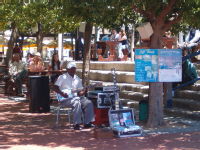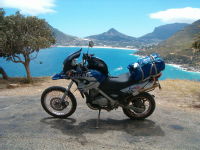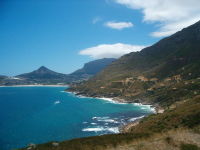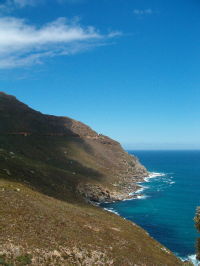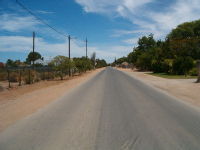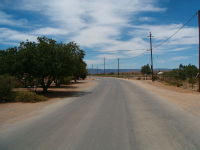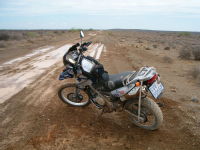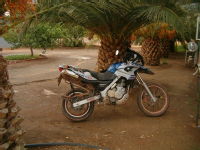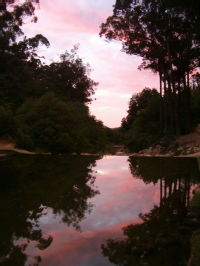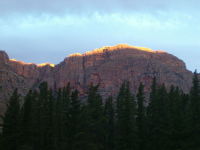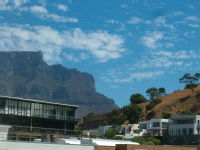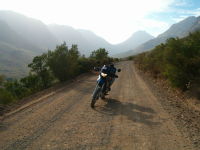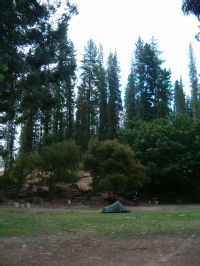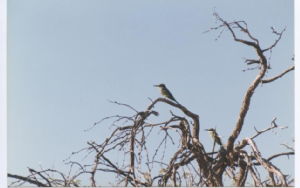All 11 entries tagged South Africa
View all 38 entries tagged South Africa on Warwick Blogs | View entries tagged South Africa at Technorati | View all 86 images tagged South Africa
February 12, 2006
Travel Report: Simon's Town day 1
Follow-up to Travel Report: Boulders Beach in close up from Transversality - Robert O'Toole
For my first morning in Simon's Town, I revisited the penguin colony. It promised to be a fine hot day, perfect for swimming, and perhaps a boat trip into the bay. Some good photographs were taken…
I walked along to the National Parks Board information centre, which offers exhibitions and a shop, as well as a screen showing a movie about the invasion of the penguins. I sat down for half an hour to watch the show, revealing just how far the penguins have gone in taking over the town.
Once the show was over, I walked out of the TV room and back into the sunlight…sunlight?...confusion! Within thirty minutes a heavy sea fog had engulfed the bay. The land was wet, and the sky dark. As it wasn't actually raining, I decided to continue my walk into town. The mist cleared a little, but by the time I reached the restaurants, I was quite damp.
I sat down overlooking the harbour, and ordered a cape malay line fish curry – "line" referring to the method of capture. This is a common feature of Cape menus, and usually indicates that the meal comprises of whatever fish had been brought in that morning, In this case it was angel fish, with delicate but substantial white flesh. The cape malay curry, in this case slightly hot, is a traditional sauce with a degree of sweetness typical of cape cooking.
Looking out across Simon's Bay, I could see vessels of the South African navy, docked in their home port. Almost 190 years ago, the same anchorage would have been occupied by the wooden sail boats of the Royal Navy's South Atlantic squadron, charged with the task of keeping the French and Dutch out and, more importantly after the fall of Napolean, of putting an end to the slave trade.
By the time that I had walked back to my rondavel, the weather had started to clear and the sun had broken through the clouds.
Part 10, Simons Town and Cape Point
Travel Report: Boulders Beach in close up
Follow-up to Travel Report: Big skies into Cape Town from Transversality - Robert O'Toole
The Cape Peninsula curves out into the Atlantic Ocean like a great arm, catching passing marine life in its grasp. To its east, False Bay provides shelter and a few vital degrees of warmth. Dolphins, whales, sharks, sea-birds and humans enjoy its waters and beaches. Of the many settlements along the mild coast of the bay, Simon's Town stands out for a unique combination of reasons. As a finale to my trip, I planned to stay for a couple of days, renting a small rondavel (thatched hut) in the well kept Caravan and Camping park.
If that sounds like rather humble accomodation, consider the views available within just a one minute walk…
And the neighbours, who employ rather unusual security guards to man their gates…
For the southern end of town is home to one of the world's most famous beaches, Boulders…
During the hours of darkness, I discovered, the penguins roam freely. I seemed to be surrounded with them and their strange braying calls. You may recogise them as of the sub-species Jackass, a most appropriate name. That is now considered by the penguin-naming authorities to be some kind of insult. And so as with many things in South Africa, they are renamed: the African Penguin. The birds themselves don't care. They know who is in charge in this town, and neither nomanclature nor penguin-proof fences will stop them.
Besides, we humans get our own back, both through overfishing and through the less serious persecution of the tourist camera…
The reward for us may be that perfect souvenir snapshot…
Or the childhood memory of a game of penguin netting…
But remember these are sensitive creatures, and if you try to walk like a penguin…
They may well confront you for your mockery…
Signs dotted around this National Parks Board managed beach warn that penguins can bite, but more usually they just retreat into the sea…
They do, after all, have a much nicer beach reserved for their own use…
What a marvellous place for both penguins and people.
February 11, 2006
Travel Report: Big skies into Cape Town
Follow-up to Travel Report: Bathtime in the Western Cape from Transversality - Robert O'Toole
I could imagine the Atlantic to the west, a fiercely constant and cold generator of weather and fate, as I descended the N7 from Citrusdal, down towards the Cape. Imperceptibly the trickle of tarmac, eroding at the edges, filled out with the signs of approaching civilization. At some point a hard-shoulder emerged as the bush retreated. The road markings became more distinct. The rustic padstaals were displaced by modern service stations of international quality. But despite all of this, a geographical and meteorological sense kept me in my place: Africa, being funneled down to its point of disappearance, the Cape of Good Hope, with the turbulence of the cross-wind from the west hitting the mountains to the east. And me on a small bike being bounced around my path, fighting to keep moving on the desired line.
At around the half way point I pulled across the road and into a whole new world: a smart new Caltex station with a Wimpy restaurant and an extensive convenience store. I went straight to the Wimpy. My need for liquid was greater than that of the bike. Riding through such hot dry wind has a dehydrating effect, and I had found that I could go for only half an hour before stopping for a drink. I bought a big cold glass of guava juice, and wandered up and down in front of a TV showing cricket. Returning to the bike, I found a couple of boys inspecting it closely. The usual questions followed, which were however not met with the usual wonderment. It seemed that for any given feature of either the bike or the journey, daddy could do better. For the required evidence, they pointed to a new luxury 4×4 with a trailer full of quad "bikes". At which point, if I could have been bothered, two-wheel-only snobbery could have been my response, there being neither skill nor adventure in such a leisure pursuit. Daddy actually turned out to be not so bad. In fact with typical South African hospitality he gave me his business card and invited me to ride on his dirt track sometime.
Back onto the highway, a little further along, the restaurant and the rich white kids were easily forgotten. I descended a gentle hill and entered a wide plain. The sky darkened ahead of my direct path. Evidence of a rain storm was obvious on the horizon. To the west I could see a gap in the weather. And then further again to the west more rain. The regions of rain and shine were so distinct as to resemble a weather map, but viewed in three dimensions from below. My summer motorcycling clothes, including a Taureg desert jacket, now promised to be inadequate. I hadn't packed even lightweight waterproofs, having expected to be riding in the Western Cape dry season. However, rain at Algeria, Brandvlei, Vanrhynsdorp and Baths had taught me that this was no normal season.
I anticipated a soaking for what seemed like half an hour. It would not be too bad, I decided. In this climate rain might even be enjoyable, although I was nervous of how it might affect the Metzeler Sahara tyre on the front wheel. And then just as I had settled on the benefits of the wet, the road turned to the west, with a degree of determination heading for the gap in the weather. Rainstorms sat on the horizon of my peripheral vision whilst my view far along the road struggled with a dazzling light.
After some time riding along this trajectory, a vast flat-topped grey shape appeared in silhouette far away.
This and many similarly grand geographies represents a third of what attracts me back again and again to Southern Africa. A second such proportion of this fascination includes the complex fine detail of the land when experienced in close-up: the people, wildlife (big and small) and the plants. The third portion consists of the irreducible convulsions and foldings between these two scales, the grand and the miniature, the geological and the personal: the eruptions of chaos and senselessness that form the history of the land as people adapt to or resist its flows and formations. My journey had worked on all three of these scales. Now my passage through the wide plains and their weather, with Table Mountain as its growing focus, acted to draw the details of these events out into my memory, giving time and space for it all to negotiate some kind of settlement as the journey.
Of course I cannot claim that my small meander was much of a diagram connecting and carrying with it a multitude of diverse points spanning a whole continent. But I do think that even a small abandonment to the laws of deterritorialization is worthwhile as a means of thinking through space and time (call it geophilosophy). This may not have been possible if it were not for the far more extensive travels, adventures and ideas of another motorcyclist and writer. And as Table Mountain grew in scale, I paid homage to that journey:
My joy is almost hysterical as I park the bike, walk slowly over the paving towards a cafe table and sit down. I have just ridden that motorcycle 12,245 miles from London, and absolutely nobody here, watching me, knows it. As I think about it I have a sudden and quite extraordinary flash, something I never had before and am never able to recapture again. I see the whole of Africa in one single vision, as though illuminated by lightning. And that's it. i've done it. I'm at peace. (Ted Simon, Jupiter's Travels, Penguin 1990, p.183)
…uncountable and irreducible points across a continent connected in a single moment, a single line or diagram of deterritorialization.
The highway doubled in size. Traffic grew slightly more angry and urban. The N7 became the N1. And finally I reached the Cape Town waterfront for a rest.
I found a drink and a lively crowd listening to a guitarist outside of the great shopping mall on the Victoria and Alfred Waterfront. At first I assumed that he was a busker. Only later did I discover that he manufactures unique electric guitars out of old drinks cans, for sale expensively in the V&A craft market.
But the journey didn't end there. With three days left, I had more points to connect.
After half an hour's rest, I was back on the road to cross the Cape peninsula for Simon's Town. To get there I followed the coastline heading south along the west. I passed luxurious hotels and busy beaches packed with bathers and policemen. The water already looked an unreal shade of blue. The colour and sense of disbelief deepened as I rode upwards and onto the coast road known as Chapman's Peak Drive. This is unarguably one of the world's great roads. Between Noordhoek and Hout Bay, with the Lion's Head mountain and the ocean as its backdrop, it rolls through 114 curves in 9km. And all the time it clings to the edge of a cliff. Recent improvements have seen the implementation of a toll, but as usual the official waved me through. I stopped at several of the vantage points, with sports bikes and pedal cyclists whizzing past behind me as I looked out into the bay.
Magnificent. See a video of Chapmanís Peak Drive on this site.
Once through to the other side of the drive, I crossed the peninsula to Simon's Town.
Part 8, Boulders Beach in close up
February 08, 2006
Travel Report: Bathtime in the Western Cape
Follow-up to Travel Report: A tale of two dorps from Transversality - Robert O'Toole
The boers are bouncing back
The fat Afrikaner's gymnastic display could be best described as anachronistic. Somehow the physical capabilities of his childhood, perhaps as a six or seven year old, had surrealistically time-warped their way into the frame of a fifty year old bouncing blubber mass. Monty Python could have envisaged this spectacle, but only at the extremity of their comic imagination.
Each time he hit the surface of the trampoline, the springs threatened disaster, but somehow they recovered in time to propell him upwards. As if that were not enough, with a wild laugh he shifted his position gracefully in mid-air, to land with a perfectly calculated (vast) bottom-first thud. This should have been the end of him, and perhaps also a large chunk of the surrounding landscape. But no, he again recovered with ease to reassume his improbable sport.
And it seemed that no other person in the vicinity had noticed. Was this normal behaviour? Is there perhaps a South African national trampolining contest, not the domain of lithe young girls but rather of grossly over-weight Boers? Most amazing was his exit. He just stopped bouncing, springing up to a standing position with cartoon-like physics and stepping off the apparatus lightly. He walked away with the casual regard of one for whom such an exertion was no more than a daily exercise. Or perhaps the assurance of a former olympic gymnast.
I sat there transfixed. And then the political analogies began to roll. One could, at a stretch, compare the political fate of the Afrikaners to the bouncing blubbery body. This of course would be deeply unfair and simplistic, but so was their regime, so they get what they deserve. The Afrikaners were never a mass, but rather were a minority with a disproportionately loud and shrill voice. They do however bounce back rather elegantly. For example, consider the new reformed Afrikaner nationalist party, the Freedom Front Plus (plus what?) Modern, liberal, inclusive – so long as each race stays in its alloted territory and worhsips the Lord. Just at the point at which the collapsing body of the AWB three legged swastika hit the bottom of the trampoline, it piroueted upwards and onwards, morphing easily into the 1930's font of the FFP's boy scout style badge (Baden-Powell, hero of Mafeking, is spinning in his grave).
As I said, the analogy is quite unfair. They have moved on significantly. But it's worth making for comic effect alone. And besides, there's some injustice remaining when a minority party attracts less than twenty people to a pre-election rally, but is still allowed a ten minute slot on the national news.
The Victorian House
So you want to know how you can get to see this astonishing spectacle for yourself? Well despite it being one of the seven wonders of the modern world, you won't find it advertised in a travel brochure.
One of the lesser known secrets of successful anthropology is this: if you really want to understand a culture, go to the place at which its people relax. Find somewhere at which they drop their guard. Sit on a shady bench, blending in with the scenery. And observe.
After riding south on the N7 for an hour and a half, my damaged wrist was too painful to continue. The tablets had reduced the swelling, but the effects of riding a light bike in a powerful cross wind had made things much worse. I passed Calvinia with its dam and water skiers, onto Citrusdal. Just outside of the town, I stopped at a petrol station, refilled, and re-examined my copy of the Lonely Planet guide. Amongst its recomendations nestled the classic South African health spa known as Baths. I called ahead and booked a large apartment for a small fee. The spring water pools and spa baths beckoned.
The road to Baths heads away from the town and into the foot-hills of the Cederberg Mountains. The tar ends at the entrance to the "resort". Once beyond the well-manned security gate, the road becomes a sandy track, even a little challenging as it raises to a slightly steep ascent. Along the track there are well-spaced camp sites, at this time occupied by a diverse range of happy campers, including one of the lamentable overland safari trucks that carry sardined European students up and down the continent.
I parked between the modern stylish restraunt and the reception. The manager apologised for having to give me an apartment on the top floor of the old Victorian House. I got a little worried by his tone.
The temporary pessimism proved entirely unwarranted once I had ascended the track a little further up the valley. The house was quite wonderful. Had it been occupied at some stage by Karen Blixen? It looked at first like a movie set. But it was entirely genuine, as a photograph from the early days of the spa proved. This really was a colonial Victorian house in original condition. And I had a large top floor apartment with great views of the hills. Surrounding the house were a few more modern building. But of them all, the Victorian House was certainly the finest. And then I realised. The manager wasn't apologising because there was a problem with the room, but rather he was sorry for having to give one of the most luxurious, expensive and big apartments to a single man on a motorcycle. I didn't complain, especially at under £30 a night.
I walked down the steps to collect my luggage. Reclining on a iron and wood bench upon the first floor veranda, I found one of my neighbours. He looked utterly relaxed and at home, as if the view through the elaborate iron lace work bannisters had long been the focus of his gaze. He beckoned me to sit next to him and converse. I did just that, for at least half an hour.
My neighbour's name was Bernard, the second of such on this journey (there also being a Bernard at Vanrhynsdorp). He was from the outset an intriguing character. A proud representative of the Cape Coloured people, with an accent and vocal character rather like that of Nelson Mandela. I exaplained my origin and journey, with some highlights of the tour so far, as well as a demonstration of my injury (holding both wrists up together showed that the right was significantly larger than it should have been). Two things became immediately apparent: 1) here was an intelligent, cultured and learned man; 2) with a genuine love of Englishness. The rest for now remained a mystery.
Baths, hot and cold
What does the term "health spa" mean to you? Perhaps a place for the healthy? Maybe a place to become healthy? Or at the very least a place in which to hold the intention to try to be a little more healthy than usual? The health resort of Baths has an entirely different ethic. By lunch time the ritual of the braii (barbecuing on a massive scale) had already begun. The delicious smell of boerwors sausage filled the air. But all was not lost. A procession of sparsely dressed people had also commenced. They were heading to the eponymous baths of this place.
And a fascinating sight it was too. There were many elegant people. There were even some very attractive ladies. And as a natural complement, there were the shockingly large white men in swimwear. The hip problems and lameness may well have just been a coincidence. However, I could not help wondering if a small reduction in the intake of meat might result in a loss of weight. This could then reduce the stress placed on their leg joints, thus making the walk down to the pools a little less painful. I'm not a doctor, so that's just a theory. Of course it makes no difference to their achievement of the most important goal in life. Each one of these tragic characters was accompanied by an attractive and skinny blonde wife. I was entirely mystified.
I overtook the limping Afrikaners, swam for some time, and noted that they never did seem to reach the pool. Odd that. The water remained the preserve of a good mixture of smiling, happy and healthy looking families, representing various hues of the rainbow nation. The adults sat around in the shallow end, chatting mildly. Occassionaly someone would embark on an adventure to the far reaches of the deeps, only to turn back at the half way point. The children were far more lively, this being a great place for them to play. A couple of spritely teenage girls undertook a hip-hop interpretation of synchronised swimming, which was both amusing and to be applauded for its creativity.
Occasionaly groups of people would suddenly emerge from the water, collect their towels, and disappear through an archway. They returned approximately ten minutes later looking redenned and somehow more awake. Despite being entirely happy floating around, my travel writing imperative nagged me into investigation. On walking through the archway, I discovered another world, perhaps akin to entering a Victorian secret garden. But not a garden as expected, instead another large swimming pool lay in the middle of it. There was, however, a subtle difference. This pool looked hot. I can't say exactly what the visual que for this judgement was, but there was a definite heat about it. I dabbled a foot to discover just how hot.
The ambient temperature out of the shade, this being the middle of the afternoon in summer, had to be over 35 celsius. To go from such atmospheric heat into hot water was a simulation of the inevitable fate of a Western Cape rock lobster. My skin turned red. I was in fact a little dizzy. But it was good whilst it lasted. After a rather pathetic three minutes I dragged myself up the steps, walked swiftly back to what I now understood to be the cool water pool, and jumped in. Now I understood the "health spa" claim – a very Victorian kind of health treatment.
It would never happen in Kelsey Park
After a few minutes in the cold pool, I was back to a normal temperature, although now with a slight sunburn. I returned to the shady bench, to be joined by Bernard, who was now at the pools with his family (his wife Maureen, daughter Bernice, son-in-law Robert, and grandaughter). We talked more, a little about South Africa, but mainly about England. Bernard and Maureen had spent several weeks in the UK on holiday. They had planned to tour Europe, but were so impressed with their first destiation in Kent, that they didn't go any further. This proved to be an ideal base for visiting London. When I enquired as to whereabouts in Kent, the reply initiated a rather eccentric behaviour from me – but I couldn't help it! With the nasal voice of a Network South East rail conductor:
"Bromley South, Beckenham Junction, Peckham Rye, Brixton, London Victoria".
I know Bromley well. Emma's parents have a flat in Beckenham. I asked if Bernard knew Kelsey Park: yes, lovely place. It is a small world.
We talked more of England, and in particular, English history. I was interested to know why so many South Africans, even those who are not of direct English descent, seem to love our grimy dark land. In Bernard's case, it seems to represent a time before the grand error of apartheid. He remembers at school an education in English, before the Afrikaner takeover. An international and broad education system was sadly snatched away from the non-white people, who had to be isolated and re-educated in the name of industrial apartheid. And then came the separation from the Commonwealth, the dissapearance of the Queen's face from the currency, the years of abandonment. I made the nearly acceptable excuse that this started during the worst economic crisis of British history (1948), but even so, I felt a little guilty. Bernard didn't mind. I think he would quite like to see the return of the Queen. I said that the British people would happily let them have the future King, so long as we no longer had to suffer him.
Regardless, or perhaps because of history, Bernard invited me to join his family for a braii (barbecue) that evening. I first had to cancel my booking for the very good restraunt, disappointing the owner who must struggle to compete with the traditional South African form of feasting. But it was too good an offer to turn down. The food was excellent, especially the spicy sausages. I sat for some time on the veranda with Robert, also a biker, and discussed sport, business (emergency service sirens, which must be doing well in SA) and bikes. Just like the rest of the family, Robert proved to be good company, and offered further insight into life in South Africa today.
Bernard returned, and we talked more. His wife was a teacher and psychologist, now retired. Their daughter, a leading clinical psychologist with the University of Cape Town, researching the effects of alcohol on pregnancy, and presenting her results in the USA. And Bernard, who at first I took to be a very down-to-earth guy, it transpired, is a retired advertising executive, having worked for one of the world's biggest firms! He sold me two things: a positive feeling about South Africa, and the idea that Bromley is the best place in London.
Life in the Cape seems to be good. This must be largely the result of the friendliness of its inhabitants, despite everything.
Part 7, Big skies into Cape Town
February 05, 2006
Travel Report: A tale of two dorps
Follow-up to Travel Report: Out of the wet season and into the dry (supposedly) from Transversality - Robert O'Toole
1) At the crossroads
The small town of Vanrhynsdorp sits at a cross roads. From south to north runs the N7 highway between Cape Town and Namibia. It is only a single carriageway of tar, and yet is a major route by South African standards. From east to west, the R27 heads through the wine making centre of Vredendal, to the seaside towns of Strandfontein, Doring Bay and Lamberts Bay.
At this confluence of two streams of traffic, I became temporarily sedimented. This was not a bad position to be in. From a brief visit to the tourist information centre, I got the feeling that it would be a good place to stop, with much of interest in the locality. It would also provide access to the doctor that I required.
My plan had been to ride out to the camp ground, recommended by the information people (a friendly man and his trainee, a young black woman). Just as I reached the edge of the compact town, something caught my attention as I passed: a flash of orange, a very specific shade of orange sitting within some kind of workshop. My attention was then drawn to a very nice hand crafted wooden sign announcing Matzikama Backpacker's Lodge.
The flash of this specific orange could only be a row of KTM trail bikes. I stopped to discover that they were lined up within a motorcycle workshop belonging to a man called Bernard. The backbacker's lodge next door turned out to be a single spacious room for three, with its own kitchen and bathroom, belonging to Bernard's mother. A perfect combination.
After a brief demonstration of the facilities, I unloaded the bike, removed my still muddy boots, and lay down on the bed. I would stop moving for a while.
There was something quite attractive about this town.
2) Drifting around town
My assumption was that towns that are closer to the popular tourist routes are a little more cosmopolitan and modern. The English language is certainly at home in Vanrhynsdorp. All of its inhabitants seemed to be at least bilingual. I would not be surprised to find that some of them are fluent in several languages – this is often the case in African tourist areas, especially amongst the black Africans, who often have a real talent for languages (I once met a safari guide who could speak English, Italian, German, French and Setswana).
The fluency of the inhabitants became obvious, as it seemed that everyone wanted to say hello. I got the feeling that word had got round that there was an English motorcyclist in town. Even the small group of people sitting in the dusty shade of a tree outside of the Dutch Refored Church building were friendly new acquintances. They looked small and dark in front of the stately towering white wood of the church, but proved to be both bright and cheerful. I bought some provisions at the small supermarket, and again was met with smiles and chat.
After a small lunch, I walked out to the local garden centre, which also hosts a large exposition of the succulent leafed plants that predominate in this region. This classification includes a range of desert adapted species, including aloes and cactii. The sandy entrance was lined with big quiver trees, of the kind that I passed whilst riding through the Karoo. These spectacular trees are like nothing that I have seen anywhere else, with the thick juicy crown of leaves supposedly used by the San to hold their poisoned arrows. I walked into the small office and tried to pay the R5 entrance fee, but the attendant told me not to bother paying. Perhaps this was due to their surprise that anyone would want to walk around in the extreme heat of the afternoon. I managed to wander around the displays for five minutes before having to retreat to the little cafe for a cold drink.
On the one kilometre walk back into town I managed to drink another two cartons of fruit juice, such was the dehydrating effect of the sun. On the way past some nice bungallowed houses, I saw how the younger inhabitants deal with the heat: a group of small children playing in a paddling pool arranged under a shady tree. This looked idyllic. A normal happy scene. But in a South African context, the mixture of races playing together in the water stood out as an extra pleasing detail. A little further, I passed the small primary school at home-time. Again the story is one of a happy assortment of children, walking home in their smart school uniforms, notably bare foot on the scorchingly hot tarmac. In contrast to the current practice amongst most British schools, even the smallest of children were walking home unaccompanied and without the aid of monstrous off-road vehicles.
I hadn't really seen much of either Brandvlei or Vanrhynsdorp, but I rapidly got the sense of them being entirely different places.
3) A David Hockney moment
South Africa has one of the best developed, efficient and luxurious tourist infrastructures of any country. There are many hotels of wonderfully high standards, as well as safari camps of sophistication. Not only does this provide a reliable source of foreign income, it also acts to raise the rest of the country culturally and socially. In parallel to this a second different but equally fine range of accomodations and activities exists to serve what has always been a thriving home market. The South Africans like their holidays, and really know how to do them well. Of this home market, the traditional guest house should be celebrated. In Vanrhynsdorp I found a perfect example. Despite the fact that I was staying in the backpackers lodge, they were happy to cook me some very nice lunches, all freshly prepared. This included my favourite combination: home made burger, chips with prego powder, greek salad, and a big strawberry milkshake. I've had some very sophisticated meals in the hotels of Cape Town, but I have to say that this beat them all.
Following lunch on my second day, the owner of the guest house invited me to have a look around. Guests are welcome to use the comfortable lounge and garden. There is also an extensive gallery displaying the work of local artists.
Word had also travelled quickly through the town that I was a man in need of a swim. The pool at the backpacker's lodge was out of action, but fortunately the owner of the guest house had a pool, and offered its use to me. But of course I had not come prepared with the appropriate swimwear. This, he said, didn't matter, the pool being enclosed with sufficiently tall walls. And besides, he would not be offended, given that we all have the same apparatus. This was said with a sufficiently Afrikaans rugby player tone to suggest no alterior motive. So i decided to re-enact the classic Hockney swimming pool scene. And I can say that it was as good as swimming in the clear blue waters of a Californian villa, bright light reflecting off the white walls and stone patio. After a while the owner reappeared to chat about a favourite subject of many South Africans, English history, recieved via a dedicated satellite TV channel. I asked if any of the artwork was his. He laughed in response:
"Do I look like an artist?"
This was odd, as he definitely did, with his French painter beard. But his passion, he explained, is opera. So the beard is more Pavarotti than Vincent.
We talked more. I was surprised to find that he is not in fact a local, but rather a refugee from Johannesburg, where his "partner", an anaesthetist, still lives and works. I wondered if there were many more people escaping one of the world's most dangerous cities for a quiet life in the country. Yes, and it seems like a good move. But does he find Vanrhynsdorp to be rather too tame in comparison? On the contrary, he enjoys the freedom and friendliness of the place. With just the right number of tourists stopping by, it offers a good level of variety and interest. That such a man could find a comfortable and accepting home in such a classic Afrikaner dorp, has to be good news. My assessment of Vanrhynsdorp rose further.
After two good nights at the Backpacker's Lodge, and having failed through happy inertia to ride my planned routes to Vredendal and Strandfontein, I pointed the Dakar south on the N7, back towards the Cederberg Mountains. However, this was not before another interruption to my progress. I was again delayed by the weather. It actually rained heavily. This was supposedly the dry season on the west coast, but wherever I go the rain follows. I seem to bring good luck to others, although itís not so fortunate for me.

Checking the bike at the backpacker's lodge
Part 6, Bathtime in the Western Cape
Travel Report: Out of the wet season and into the dry (supposedly)
Follow-up to Travel Report: Apartheid geography in South Africa today from Transversality - Robert O'Toole
Upington, I heard, was rather wet. A nice small town in the south west Kalahari, I had been anticipating revisiting its lovely green camp ground next to the Gariep (Orange) River, and sleeping under the big palm trees. I telephoned the Professor at Kalahari Trails, the destination at the end of my plan. They still had no rain after a three year drought. However, I was concerned that with so much water between Brandvlei and the reserve I might not make it through, especially on the sandy dirt tracks – the "awful red stuff". Even worse, I might make it through but then find my way back transformed into a swamp. I have seen photos of the duneveld under water, and conclude that it is no place or a motorcycle.
To complicate matters further, I would have to carry spare fuel as a guarantee. There would probably not be anypetol available north of Upington. Carrying a 5 litre can strapped to the seat would make the bike difficult to handle. With a rapidly swelling right wrist, onto which I had fallen in the mud, I seriously doubted that contunuing north would be a good decision.
As I rode south on the tar to Calvinia, my decision was justified. The strong westerly cross wind, combined with the revving of the 650cc single cylinder engine, put pressure on my damaged wrist, thus making the injury worse.
Having discovered that the drought in the interior was coming to an abrupt end, I turned back towards the coastal plains. Back into the winter rainfall zone, supposedly back into the dry. With mild but unrelenting pain running through my right arm, I passed through Calvinia and on to the small town of Nieuwtoudtville. To find its petrol station, I had to turn briefly off the tar and pass its impressive wooden church, stopping to ask for directions from a bemused Afrikaaner lady. At the petrol station I discovered a double surprise.
Firtly, a man on a bicycle stopped by to look at my bike. He was also a BMW Gelandestrasse rider, owning an R1150GS. We chatted for a while and shared news of the various roads and interesting destinations in the are. I gained three useful items of intelligence:
1) The Vanrhyns Pass is treacherous in the wet, as the badly maintained trucks that crawl around it tend to drop diesel on the tightest of its turns. In fact, a couple of bikes had recently slid off, but survived.
2) The R27 coastal road, of which I had assumed to be good tar, is in fact rough dirt with hidden sand filled pot holes.
3) It would be worth spending some time in Vanrhynsdorp, Vredendal and Strandfontein.
As he cycled off, the GS rider said that I should look inside the adjacent workshop, as it contained something that I would find of interest.
I followed his instructions, to be amazed by what it contained. The darkly lit building contained a small collection of classic bikes, including a pre-war BMW sidecar combination and an early air-cooled R80GS. I asked the petrol attendant what he knew of them, but his English was almost non-existent. Finding no one else to inquire with, I got back on my bike and rode off. The R80GS would be a perfect bike to own in Africa, much more suitable than the F650GS Dakar. Perhaps one day I'll return with a bundle of Rands to make them an offer.
I descended through the pass with even more care, wobbling around every corner in fear of the diesel spill that would send me sliding over the precipice. Of course it never happened, the road surface being dry, in fact so hot that I could smell my tyres melting. At the bottom of the pass, I shot out onto the plains like a rifle bullet. Accelerating quickly up to 120kph despite a strong head wind, the attractive little town of Vanrhynsdorp appeared on the horizon.
Read part 5, A tale of two dorps
February 02, 2006
Travel Report: Apartheid geography in South Africa today
Follow-up to Travel Report: Eating mud in the Karoo from Transversality - Robert O'Toole
1) Meteorology
The land of southern Africa is more clearly than most the product of an ongoing confluence and dissipation of flows, both great and minor. Two ocean currents run into its coastline: the cold Benguela from the west and the warm Agulhas from the east. Pulled with them are the streams of weather and humanity that determine the fate and fortunes of both the coast and the interior.
As with most flows, obstacles are met with. They act to deflect, cancel-out, or filter the matter carried upon them. In the case of South Africa's weather, these filters include the mountain ranges that run along most of its coastline. So great is the effect of these mountains that climates may vary dramatically within just a short space.
Over 200kms, riding between the west coast plains and the Karoo plateau to the east, I experienced this geography closely and directly. To pass eastwards across the Bokkeveldberge range, I filtered through its high ridges along the slow and sharply twisted Vanrhyns Pass. At times this necessitated dropping down into second gear at a mere 30kph. There was an irresistible tension between looking out far into the distant views and negotiating the difficult road immediately under my wheels.
And all of the time, I could feel the weather moving along with me. The strong winds from the Atlantic, 100km to the west of the pass, followed me upwards. And then as soon as I emerged onto the plateau, their potency was lost. Solid banks of cloud follow the same route, only to be dissipated as they brush the peaks. To a motorcyclist the effect is quite the opposite, being concentrated into the onward flow, channeled into something more intense, rather than dissipated into the terrain. The drive is to seek more encounters with this vast geography, whilst getting close enough to the harshness of the conditions to feel one's trajectory shaped by its grip. A great road like this sucks you in, washes you about, and then spits you back out.
This transition, from the low lying west to the high plateau of the centre, also marks the shift from the winter rainfall zone, in which the rainy season centers upon August, to the summer rainfall climate, with its rain expected towards the end of the year. I had already on this trip experienced a reversal of these expectations, with my tent being doused in rain while camping in the Cederberg Mountains. As I was to be told by many that I met, some other force must be interfering with the patterns, thus seriously upsetting the usual weather – that force could just be the bad luck that I personally carry, or perhaps a more general misfortune: climate change.
As the meteorological flows found their consequence, it was more than just my tent that felt their effects. All life in these parts depends upon their vicissitudes. To the west, the rains result in the most spectacular of wildflower displays. Desert plains become rich with life and colour instantly, until cruel desiccation returns. Sheep farming is also at the mercy of the interaction of meteorological flow and filter. When the rains came, my new friend Pieter the farmer celebrated, even though it meant that I had to battle through the mud.
While I struggled in the morning's swamp on the road to Brandvlei, I passed another result of the interaction between rain, land and life. Dead young springbok antelopes lay in puddles. These animals flock towards rainfall, often traveling great distances to meet with a shower on the horizon. I'm not sure what had caused these unfortunate deaths. They looked as if they had drowned in Pieter's bounty.
And finally at the remote dorp of Brandvlei, I came to a more disturbing intersection of flows and filters. On the back-road to the old Boer republics, alongside a vlei (shallow depression in which water gathers), someone had taken the distributions of people and cultures sedimented out of the geographical flows, and applied alien rules to separate and segment their arrangement on the surface of the Earth: apartheid.
2) How did he get here?
People flow, or rather drift if one considers generations. And out of the flows they gather like sediment. Those that are too weighted with possessions and affiliations sink to the bottom and form a relatively solid bed. These foundations in turn attract and catch more individuals from the flow, offering a place to rest and shelter. This is how tribes and villages form – distributions of aggregate created when flows of people meet obstacles that filter and form. Most places in South Africa lie on top of such rocks. However, their geology is often folded and re-distributed by more violent, terrible and urgent forces than those of sedimentation.
At Brandvlei, I found the political geology of South Africa exposed on the surface for all to see, with its contortions and fractures. As my new friend Jacob set to work on washing my bike, a commonly fat Afrikaner man stepped out of the hotel's side door to give me a warning.
"Be careful, watch him closely."
He said this with some menace, reminding me of the Cape Town taxi driver who told me not to go out after 5pm. The message was clear: Jacob was a black African, in need of supervision and deserving of suspicion.
In reality, forgetting the colour-fearing reactions of the wealthy white man, Jacob was entirely trust worthy and self-sufficient. When I asked of his bike washing fee, he didn't seem bothered at all. As we talked it became clear that the bounty that he sought was primarily contact with the outside world, and secondarily some payment for his enterprise.
We talked about England, Tony Blair (universally disliked) and Manchester United (universally popular). I tried to explain the location of Kenilworth, my home town. And as usual I shared a fact about the UK to which the response is always pity: 08:30 sunrise, 16:30 sunset, overcast gloom all day.
But what of Jacob? He explained his most important principle:
"I believe in delivery not promises."
This was, I guessed, a sharp retort to South African politics, and implicitly, the corruption ridden ANC. In such obscure places as this, as in many more significant settlements, progress has been slow, with politicians taking only an occasional and well timed interest. A segmentation of the population is still clearly visible: the black third world on one side of town, the white first world on the other. Many towns even have a second poorer twin, euphemistically called Sometown-Wes. Brandvlei seemed too small for such an arrangement, but the contrast was there all the same.
Jacob explained the current situation, the disappointment and confusion, the corruption case of Deputy President Zuma and the forthcoming elections. He seemed positive despite all of this. As an attempt to fuel his optimism, I explained how Botswana, Africa's oldest and most successful democracy, had just been rated as one of the least corrupt countries in the world. This pleased Jacob, although he seemed to know very little of the black African nation just to the north, his knowledge of Europe being greater than of Africa.
I had expected that Jacob would have some tribal or linguistic connection with the world beyond the Afrikaner dorp. Perhaps he spoke Setswana, the language of Botswana and northern areas of South Africa. But he knew nothing of it. Perhaps Xhosa, the most popular African language? No. Zulu? No. Pedi? No. The language of his limited schooling was that of the apartheid overlords, Afrikaans. English, the language of Beckham and Scholes, seemed to be his adopted preference. Despite all of the attempts of the old regime to prevent him, he was quite fluent, and enjoyed using it.
Jacob then offered an explanation for his lack of an African language. His reasoning was to me quite surprising. He claimed to be neither "black" nor "African". He is adamantly "coloured". Whereas in England this is a rather old fashioned polite term meaning "black", in South Africa it has a complex political root. Further south, in Cape Town, there are a group of people known as Cape Coloured. They have their own fascinating history, including some appalling treatment from the old regime. Despite this, or perhaps as a result, they have a friendly character unequalled anywhere.
But Jacob is not Cape Coloured. Rather, his "classification" is the result of the old regime's hypocritical abuse of the term "coloured". To understand this term in its context beyond the Cape, one must first know a little of the regime in which it sat uncomfortably but irreplaceably.
The core idea behind apartheid, its pseudo-scientific excuse, was that each distinct race benefits from living separately from all others. A kind of simplistic ecological evolutionary thinking underpinned this. The black Africans were claimed to have descended from the north, deposing the native bushmen in a recent, primitive and brutal invasion. They were said to have settled in lands suitable to their iron-age cattle keeping simplicity. And from the south, with technology to conquer the seas, the mountains and the deserts, came Europeans. Being more sophisticated and capable of exploiting a different range of resources, the settlers found lands for which they were specifically adapted, principally those suitable for modern farming, and more recently, those containing the ores and gem stones that could feed their natural enterprise and industrial tendencies. Thus apartheid claimed to be an encoding in law and politics of the naturally occurring distributions of people into the territories, according to principles of evolution and adaption. So confident was the regime in its theories, the flow of people and history was to stop with its final solution.
But of course this was an inaccurate model of the flows and sedimentations that formed pre-colonial South Africa. A much more complex and dynamic world is closer to the truth, with well established trade routes and inter-dependencies between cultures and localities. More fatally for the dream of the apartheid theorists, it proved to be an inaccurate and unfeasible vision of modern South Africa as well. The flows of capital and the expansion of industry demanded a more mixed and closely knit society. Enter the people designated as "coloured".
As a vague and artificial classification, the term "coloured" neatly addressed the contradiction within industrial apartheid: how to create a mobile controllable black workforce that is neither hindered nor empowered by links to tribes and territories? Take away their language, culture and even their link to Africa, and you have them as a controllable force on tap.
Jacob then is at least in some small part involved in this context, although I suspect that he is finding his own way out. The population of Brandvlei, I suspect, is even more locked in to the failed segmentation, coding and ad-hoc classifications of apartheid. I heard it said that the owner of the hotel had been trying to establish a better relationship with the local community and his workforce. This, I was told, was met with disapproval from local whites. He seemed a pragmatic and welcoming character, with only a hint of Basil Fawlty as he struggled with the sprawling establishment. In a bar room conversation, his elderly father revealed a nostalgia for old cars and his native Rhodesia, as well as a nauseous response to inter-racial marriage. This was said after I talked of my links to Botswana, the first president of which was famously married to an English Lady.
Despite all of this, Jacob proved to be friendly, talkative and wise. Cleaning the bike took around 15 minutes, during which we talked about all kinds of matters. As I seemed eager to get back on the road, he wisely concentrated upon removing the thickest layers of mud, especially the deep layer stuck to the wheel rims and spokes. This would improve the bike's handling somewhat. As the job neared completion, an incident occurred that indicated that he was more than just an itinerant odd-job man. I began to suspect him of some kind of higher standing in the local community. As I rummaged through my wallet in search of Rand notes to give in payment, another man approached us, perhaps sensing an easy opportunity. Despite being a much younger man, he addressed Jabob as his "brother", which I know not to take too literally. In fact Jacob seemed not to approve of this claim to familiality. The second man was trying to muscle in on Jacob's enterprise, with an almost comical spot of mirror wiping and dust brushing. Jacob became more displeased, but stayed calm all the same. When it became clear that his ploy was doomed to fail, the man resorted to shameless begging. Jacob's response was impressive in its clarity and firmness. He said to his illegitimate brother:
"Do not cross the border".
The meaning was clear: keep your self-respect, do not become a beggar. But there was also a degree of embarrassment, perhaps in that a "relative" would lower himself to this, or perhaps in the return to the old days that it suggested. More fundamentally, it demonstrated that Jacob has taken control of the racial segmentation, set his own borders clearly, and is prepared to defend his ground.
I decided that the best solution was for me to get moving as quickly as possible. I said goodbye to Jacob and Brandvlei, thanking him for his help and good conversation. Thanks to him, an unplanned stop in an unpromising town had in fact taught me much about South Africa and its people.
Part 4, Out of the wet season and into the dry
January 28, 2006
Travel Report: Eating mud in the Karoo
Follow-up to Travel Report: In the Cederberg Mountains from Transversality - Robert O'Toole
Two phrases became imminent as I hit the desert floor:
"How did I get here?"
And simply:
"Oh bugger!"
The latter of which was voiced to an on-looking audience of red sand, rolling bushes, and a small flock of bemused sheep.
I instantly knew my exact location: lying across the edge of the dirt track between Loriesfontein and Brandvlei, eating mud in the vast emptiness of the Great Karoo arid plateau, in the North West of South Africa, in a small amount of trouble. And my bike? In a similar position, but with its left handlebar embedded 20cm into the ground, engine still running, and seemingly intact.
Upon getting to my feet, the pain of a rapidly swelling wrist failed to distract me from the recurring question: exactly how did I get here?
I can give a few simple but insufficient reasons. Firstly, I took the wrong road out of Calvinia to Brandvlei. This can't be as stupid as it sounds. I made the same mistake last time I traveled to Upington in the Kalahari. This left me with 200 kilometers of dirt to cross. Having done the same trail before (in a Hilux), this should not have been a problem. In fact it was what I came to South Africa to do. This too was a factor that led me to this position, standing in the muddy edge of a remote desert track.
My aim was to ride long distance on the empty back roads, over gravel and sand, skipping across the corrugations. Moderately difficult riding, but much more enjoyable than churning through the mud of Salisbury Plane. The ride had indeed met up to its promise, and in fact included one of the most enjoyable corners I had ever traversed: a steep rise and adverse camber, with corrugations and loose sand causing the rear wheel to lose grip and slide outwards. Only by standing up and controlling the balance of the bike carefully did I get the required traction to power round the bend.
After almost 160 kilometers of getting really good at riding these conditions, spotting the good tracks and the bad tracks, seeing the colour of the dirt change between yellow, grey and red, I came to something quite unexpected: mud, inglorious mud.
At a very definite point in the track, its colour changed from soft yellow to dark brown. That point was only 35km from the tarred road at Brandvlei. Worse still, I didn't have enough petrol to turn back to Calvinia.
Before making a decision, I spent a few minutes admiring the line in the sand – a wonder of meteorology. There was a clear and distinct point at which the rain had not reached, marked by a solid line. When it does rain in these areas, it is usually quite localised. Not the all encompassing blanket drizzle of England, but rather small patches of intense downward driving rain. Sometimes the rain is capable of denting car roofs.
The sky all around was clear. The heat was burning. The mud would be drying fast. How localised was the rain? Perhaps it just covered a short stretch of road. The alternative being too terrible, 35km of muddy hell, I decided to be optimistic and have a go.
Standing up on the pegs and keeping down to 20kph, I did well and slithered through several small pools. It was just like the ride to Stonehenge – heroic stuff ending in the bike becoming cross rutted in a deep pool, front wheel heading in the opposite direction to the rear. My clothes were fortunate that I managed to make it beyond the deep mud before bailing out.
The bike was also almost undamaged. I paused for a few minutes, and then un-strapped my Ortlieb dry bag from the back. This reduced the weight and made lifting the 185kg bike possible. But first I had to dig the left side of the bars out of the mud. A big gloop of mud had forced its way around the plastic hand protectors, which were undamaged. However, the clutch lever had snapped half way along, in exactly the correct position to leave it rideable.
Once the handlebars were unearthed, I turned them so that I could pivot the bike around the wheel. With a single movement it was up. I extended the sidestand, which found firm ground. By this time the bike was pointing in entirely the wrong direction – back into the mud. There was no other option but to start the engine, hand change it into first, and walk it back through the pool. Once on the other side, I returned for my luggage and reloaded it.
And then Pieter the farmer arrived, perhaps tipped-off by his sheep that something odd was going on. Mud was respectfully forgotten for a while as we chatted about farming and its problems. Above all we celebrated the rains, good for the lands and hence for the sheep. Even more so because these were the first since last March, and the heaviest in three years. He politely apologised for my bad luck in being a victim of his good fortune. Perhaps this may have also been a motivation behind his generosity in helping me.
But before we got to the business of finding a solution to my immediate problem, we talked politics and economics. Specifically, the issue of subsidies. Pieter works hard to produce fine lamb in such a harsh climate. He employs many people who also work hard all day through the intense heat. His sheep are a big investment, and a matter of pride. But the world is not fair to Pieter and his people. In translating from his native Afrikaans to English he struggled to find the correct phrase. I suggested "cannot compete". There was however one word that he knew perfectly well: "subsidies". In the now distant past, South African farms received subsidies. This at least gave a select few (white owned) farms a small chance of competing with the heavily subsidised EU and USA. Economic pressures, the impositions of lenders and donors, and political changes, have left all farmers in SA equally defenseless. Pieter has done well to find a niche market, selling quality lamb to the Islamic market. But it is still a struggle. I explained that most UK politicians wish to abolish subsidies. I blamed the French, which always seems to go down well. However Pieter rightly pointed to the Americans as being the real and immovable obstacle.
At which point I said "oh well, at least you've had good rain". We laughed again at our opposite fortunes, and returned to the pressing issue of 35km to Brandvlei.
As he had recently driven from that direction, and possessing a farmers acute memory of physical conditions, Pieter could give me a detailed description of every obstacle: three large pools, a broken concrete dish drain, and "that awful red stuff". But he knew that the road was drying fast, assisted by the sun and the wind, and hence he was sure that I could make it through. In fact he was determined that I would do it. If necessary, he said, he would help to push the bike through himself. Perhaps he assumed that I am much tougher than I really am? I had said that I am from a town near Rugby. That always seems to impress South Africans disproportionately. Anyhow, he was confident, and even offered to lead me through in his pick-up truck.
With the back of the truck reloaded with farm workers and a single bleating sheep, Pieter led the way. I knew that I was slowing him down, although not by much, as the road was so bad that even a 4×4 had to go slow when fully loaded. And so I followed, most of the time with a single foot on the ground to prevent the back from sliding too far. Too pass through the really difficult sections, I paddled with both feet down. The knobbly Metzeler Sahara front tyre gave good grip, but the dual purpose Bridgestone Trailwing at the rear was almost useless. It slithered around promising to dump me back onto the ground. Despite this, I continued.
The technique proved most effective. After about 15km, Pieter stopped to tell me the worst was over. And it was true that, as he had promised, the road was drying fast. At this point he left me to check on a rain gauge off in the bush – a rare thing for him to do. With the promise that he would not be far behind, I continued with caution.
And then came the "awful red stuff"'. This was the red sandy soil more usually found in the Kalahari region further north. As I reached the edge of the transition in colour, I slowed to around 10kph. It seemed fine for a while, until I came to the first pool of water. I found a drier path to the right, paddling through with both feet and, most alarmingly, with the rear wheel being sucked ever deeper into the mud. I could feel the sudden halting of my forwards motion as the mud came over the wheel rim, clogging the spokes. Bloody awful red stuff.
This happened on three occasions, each as mighty a struggle as the last. The only way to escape the grip of the mud was to rock the bike backwards and forwards, whilst revving the engine hard and using the clutch to release bursts of power at just the right point. This worked, but was not at all easy.
As I passed out of the red stretch of track the small town of Brandvlei appeared in the distance, along with a large truck, complete with suitably tractor style tyres. I knew that he would make it through, but would the track surface survive his passage? Maybe I was lucky to have got through before him.
The last few kilometers were done at greater speed, but not without a few more slides of the back wheel. And then I reached the tar. As Pieter had promised, I made it through. I rubbed the mud away from the clock on the dashboard. 35km had taken me an hour and a half. But it had been a challenging and fascinating time.
Part 3, Apartheid geography today
Travel Report: In the Cederberg Mountains
I have a great new discovery, for which I make several astounding claims. A newly revealed holistic therapy. A miracle cure for both body and mind. Really, itís true, Iím not trying to con you out of money, or sign your soul away to some mad new religion.
At least it did work for me. See if you think it sounds like a panacea. Here is what I prescribe…
The treatment itself is simple, but with several necessary and arduous precursors. Let's start with the final and most pleasant stage of the process. You must be immersed to the shoulders in the warm and clean waters of a mountain stream. A wide and calm pool at the side of a ford is a prime location for this. Then you must stand on one foot, balanced perfectly on an appropriately sized boulder. You then spin slowly in a clockwise direction. A velvety carpet of moss may assist in the perfection of this maneuver.
This slow rotation allows for the rhythmic apperception of a horizon of golden and red cliff faces, fronted by giant cedar trees, and topped with a bright and clear blue sky. Whilst at every point in the rotation, the sweet cedar aroma, and the pulsating buzz of millions of insects, remains a constant intensity.
One should also try to ignore the occasional curious fish swimming in close proximity. Treat it with a certain Buddhist indifference.
Does that sound good? Do you want to have a go? Recall that I described this as being only the final stage in the process. Remember those arduous but necessary precursors?
To start with, you must fly to Cape Town. There are means of transport less torturous than British Airways, but I suspect that the body and mind must be thoroughly broken before they can gain salvation through the cure described above. Paper thin seats with no leg room are the most efficient means to inflict the required degree of pain. To make things worse, become separated from your beautiful wife and baby at Johannesburg, for they have other plans.
At Cape Town, take the shuttle bus from the airport, allowing the talkative driver to both amaze and terrify you. On the one hand it is said to be a city of harmony, integration and culture. Whilst on the other, you are told not to go out after 5pm (sunset is currently 8pm), or you will definitely without a doubt meet with a terrible fate.
Next, I recommend an intellectual challenge. Stay at the fine Victoria Junction Hotel in Cape Town. Take the opportunity to rigorously debate skepticism, Empiricism and theology with the philosophically adept waiter by the name of Junior. His renditions of the speeches of Martin Luther King are inspirational.
The following morning, you must collect a BMW F650 GS Dakar motorcycle from Karoo Biking. The next stage of the process consists of a journey for which only this bike is suitable. Firstly, ride out of the urban sprawl with the agility of a springbok. Then, blast up the N7 highway at 120kph, passing double-articulated trucks with ease. And finally after 200km, turn of the tar and onto the dirt. The high speed vibration of the big single cylinder engine adds a further degree of stress, particularly to the hands and feet – precisely those areas reached most immediately by the ďtherapyĒ.
The Algeria campsite in the Cederberg Wilderness Area is about 30km along the dirt road. The build up to arrival is increasingly impressive. The track winds through a mountain pass, with some moderately steep rises and descents. The surface is mostly good smooth gravel, with the occasional loose scree and exciting adverse cambered rising bend. The views forcibly distract one's attention from the task of keeping it upright and forwards flowing. But I have to say it was for me a great ride.
On reaching the camp, take of your helmet and ear-plugs, and think you have suddenly developed tinnitus. After the panic subsides, realize that the bush here is packed with insects. Loud and perfectly well synchronized insects.
Finally, you have a choice. Either set up camp in one of the spacious shady spots (they also have some chalets), or proceed directly to the therapy pool. I chose the latter option, fully clothed (remove helmet and heavy biker boots first).
As someone once said, this is how religions get started.
Onto part 2, Eating mud in the Karoo
October 18, 2005
Travel Report: Bike expedition to the Kalahari booked
Writing about web page http://www.karoo-biking.de/en/index.php
I shall fly to Cape Town and hire one of these from Karoo Biking:

from the official BMW GS web site
…that is a BMW F650GS Dakar, a smaller and lighter Gelandestrasse than my R100GS Dakar, but just as capable an off-road tourer (it has won the Paris-Dakar rally twice). Tank range might be a problem, I guess that it will do about 300km's between fills, so I may need to carry a small plastic can. I've got some lightweight camping gear, which I will carry in a Gelert dry bag bungeed to the seat and rack.
And then i'll head north through the Karoo, the arid plateau in the centre of South Africa. I have travelled a similar route before. From the cold Atlantic coast, the amazing long climb over the Swartberg. Flamingoes in the salt pans between Calvinia and Kenhardt. Northwards into the absolute desert of the south-west Kalahari…

a photo I took last time I went to the SW Kalahari
It's been far too long since I was last in a desert (a trip to the Moroccan Sahara being the last). I miss it so much. I'm planning to head up to Pofadder, and then take some of the dirt roads to the west. Looking at the 1:25,000 South African government geographical map that I have, I can see some fascinating terrain – including dunes. And looking at the satellite images on Google Earth, I can even see some of these features in 3-d:

from the Google Earth satellite maps application
The small communities between Pofadder and the Richtersveld (an empty rocky desert area on the border with Namibia) are initiating "community tourism" projects, with camp sites and small nature reserves. If possible I will investigate these. I will then head west to the coast. I'm not yet sure where i'll hit the coast, perhaps as far north as the mouth of the Gariep (Orange) River. I will definitely revisit the gannet and penguin colonies at Lambert's Bay, looking for whales along the coast.
And then back to Cape Town, possibly visiting some of the national parks along the Cape coast.
Once I have returned the bike, i'll fly up to Gaborone, Botswana for a couple of weeks with Emma and Lawrence.
October 11, 2005
Travel Report: Kgalagadi (Gemsbok) Transfrontier Park, SA/Botswana
Writing about web page http://www.sanparks.org/parks/kgalagadi/

The Kalahari Gemsbok Park in South Africa, which has now become the Kgalagadi Transfrontier Park with its merger with the Gemsbok Park in Botswana across the border, is my favourite of the southern African wildlife reserves. It combines four of my top priorities: full desert with dune fields, big game, raptors, and a diversity of small but fascinating mammals.
After a long drive from Botswana, including a stop in Hotazel (pronounced Hot-as-hell, which is exactly what it is), as we neared the park the dunes began: red, sweeping, burning dunes – not as large as those of Merzouga in the Sahara, but all the same quite sublime. If you have never been to a desert dune-field, imagine yourself at the seaside, but with no sea, no water, no civilisation anywhere to be seen.
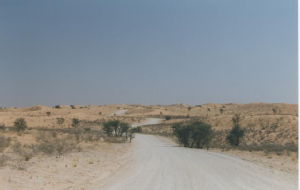 | 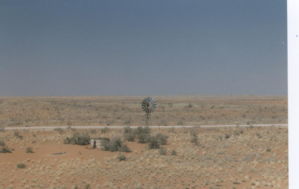 |
Dirt road through the dune fields. | A wind pump in the desolate Kalahari. |
But there is life. First of all, the tsama melon with its deep tap root accessing hidden water and swelling into a fruit:

These, and other such drought-defying flora, provides sustainance to an amazing variety of fauna, such as these dune-dwelling ostriches:

A food chain that even extends to the most powerful and hungry of predators:
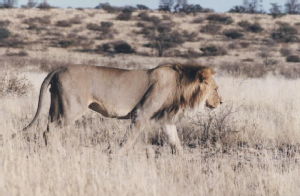 |  |
Our first drive out into the park gave us a dramatic view of these predator-prey interactions:
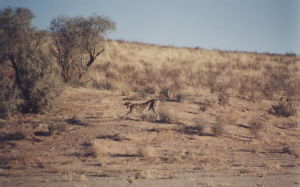 | 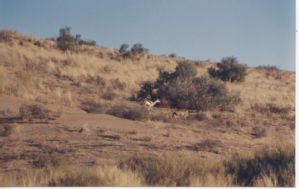 |
A hungry cheetah. | A meal wanders over the brow of a dune. |
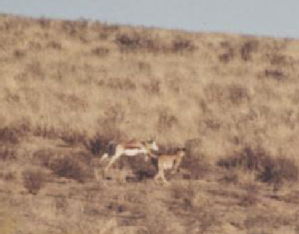 | 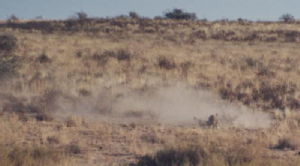 |
High speed chase between cheetah and springbok. | The springbok is tripped and the killer engages the prey. |
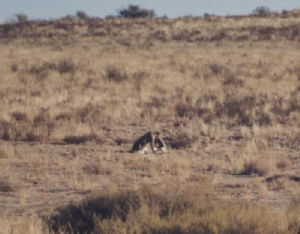 | 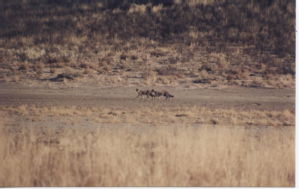 |
In an instant the springbok is converted into a meal. | Not cruelty but necessity, as the cheetah's young join its mother. |
But it's not all brutal drama in the sands. A wealth of smaller but equally beautiful creatures can be found, including some superb small carnivores:
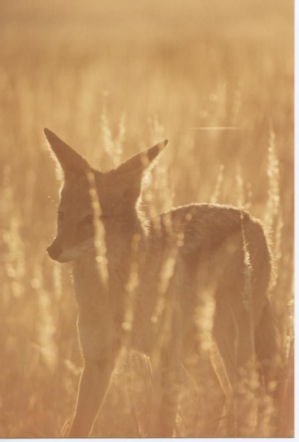 |  |
Side-striped jackal in the morning desert light. | Jackal portrait. |

A group of african wildcats, they actually behaved very much like domestic cats, and at one point walked under our Hilux.

The insectivorous bat-eared fox.
The birdlife is also surprisingly prolific:

A kori bustard.
We experienced many close-encounters with raptors:

Pale-chanting goshawk with a kill.
After several nights spent in the park, staying at the good National Parks huts at Nossob and Mata Mata, we left the desert with some great memories, not the least of which was of the gemsbok antelope after which the park is named, to be found deep in the dunes, looking quite majestic:






 Robert O'Toole
Robert O'Toole

 Please wait - comments are loading
Please wait - comments are loading












